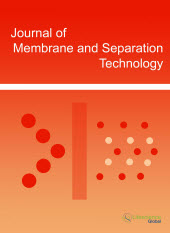jmst
Abstract : Mechanical Characterization of APA Microcapsules by Parallel-Plate Compression
|
|
Abstract: We produced microcapsules of alginate-poly(L)lysine-alginate (APA)with diameters on the order of 10 µm. To characterize their mechanical properties, we conducted an experiment on the parallel-plate compression of a microcapsule and modeled its deformation. In the modeling task, the microcapsule was assumed to be a spherical liquid-filled elastic membrane with negligible bending stiffness and permeability. The membrane thickness was estimated by applying Reissner’s linear elastic theory to the experimental force-displacement relationship during loading in the small displacement region. The initial stretch of the membrane was taken into account; it was mainly caused by the osmotic pressure difference across the membrane. The initial stretch of the microcapsule was determined by fitting the calculated and experimental force-displacement relationships during loading at small to medium displacements. At large displacements, the calculated force was smaller than the experimentally measured force because of fluid permeation across the APA membrane. The calculated and experimentally imaged shapes of the deformed microcapsule were compared. The effects of varying the membrane thickness on the force-displacement and transmural pressure-displacement curves were shown, and the limitations of applying the present deformation model were examined. Keywords: Microcapsule, compression, modeling, mechanical characterization, initial stretch. |
Abstract : Applying the Berberine-Pretreated Filter for Inactivating Bioaerosols
|
|
Abstract: This work considers the effects of using the berberine pretreated filters (BPFs) as the antiseptic filters on the bioaerosol penetration. Two concentrations of berberine solutionswere used to coat on the polypropylene fibrous filter. The Escherichia coli (E. coli), and Bacillus subtilis (B. subtilis) bioaerosols were generated using a Collison nebulizer, as the challenged bioaerosols. The effects of various factors, including the face velocity and the relative humidity on the bioaerosol collection characteristics were evaluated. Experimental results suggested the pretreatment of berberine did have an antiseptic effect on bacteria bioaerosol and increase the inactivation mechanism. The filter pretreated with a higher concentration of berberine has a stronger antiseptic effect on bioaerosols. The culturable survival of E. coli bioaerosols through the untreated filter, the 0.002 wt%, and 0.02 wt% BPFs are around 68%, 43%and 36%, respectively. In addition, the culturable survival of B. subtilis bioaerosols through the 0.002 wt%, and 0.02 wt% BPFs are around 66%, 51% and 43%, respectively. Moreover, the culturable survival of E. coli bioaerosol through the 0.002 wt% BPFs increased from 43% to 54% as the face velocity increased from 10 to 30 cm/s. These results indicated that the antiseptic of the BPFs decreased with face velocity. Keywords: Berberine pretreated filters, Survival, Bacteria bioaerosols, Face velocity, Inactivating. |
Abstract : Improved Gas Separation of PEBAX-CSWCNTs Mixed Matrix Membranes
|
|
Abstract: In the present study, mixed matrix membranes (MMMs) were prepared using PEBAX® 3000 as polymer matrix and single-wall carbon nanotubes (SWCNTs) functionalized with carboxyl groups as nanofillers. The effects of the nanofillers on separation of CO2/N2 and CO2/CH4 were investigated. The pristine PEBAX membrane indicated gas selectivity values of 23 and 13 for CO2/N2 and CO2/CH4, respectively. However selectivity of the modified membrane for gas pairs of CO2/N2 and CO2/CH4 improved to the values of 106.4 and 31.3, respectively. In other words, selectivity of modified membranes compared to those of unmodified ones enhanced greatly. The dramatic increase in gas selectivity of the mixed matrix membranes can be attributed to the polar groups of caboxyl-functionalized single-wall carbon nanotubes (CSWCNTs). While CO2permeability of MMMs increaesd, permeability of nonpolar gases (N2 and CH4) decreased. FTIR spectra depicted that there were inter/intramolecular forces between ether and amide groups of the polymer chains. For PEBAX membrane filled with 10 wt% CSWCNTs, the peaks of C-O-C، N-H, and H-N-C=O functional groups shifted to lower values due to the formation of hydrogen bonds between polar carboxyl groups of CSWCNTs and amide/ether groups of PEBAX copolymer. Relative crystallinity values of the membranes with various CSWCNTs content were calculated using ΔHf data obtained from DSC measurements. Results demonstared that the rise in content of CSWCNTs brought about the decrement in crystallinity values of polyamide segments. The morphology of the membrane containing 10 wt% CSWCNTs was also investigated emplying AFM images, and a suitable compatability and adhere between PEBAX and CSWCNTs was last confirmed. Keywords: Mixed matrix membranes (MMMs), Poly(ether-block-amide), Nanofillers, Permselectivity, Gas separation. |
Abstract : Nanoporous Polyether Sulfone Membrane, Preparation and Characterization: Effect of Porosity and Mean Pore Size on Performance
|
|
Abstract: Flat sheet membranes were prepared by phase inversion technique using polyether sulfone (PES) dissolved in dimethylacetamide (DMAc) with and without adding polyvinylpyrrolidone (PVP) or polyethyleneglycol (PEG). The characteristics of the prepared membranes were evaluated using Scanning Electron Microscope (SEM) images, Atomic Force Microscopy (AFM), and Optical Contact Angle (OCA) measurements, and porosity tests. The porosity test and SEM images show that increasing additives to a certain value increases the porosity of the membrane. Also, as the coagulation bath temperature is increased, the porosity of the membrane is increased. The roughness of the membrane is increased by increasing the additive concentration. The analysis of AFM images confirms the nanoporous structure of the prepared membranes, and that the membranes with appropriate pore size distribution can be prepared by the applied method. Permeability tests using single-layer membranes show that the direct relationship between porosity and the flux of pure water or salt solution is dominated by the effect of applied additive while the salt rejection shows an inverse relationship with the mean pore size regardless of the applied additive. The salt permeation flux is a function of total porosity while the salt rejection is a function of surface porosity. Pervaporation tests show that both permeation flux and enrichment factor depend on the total porosity of the support membrane. Keywords: PES membrane, Porosity, Mean pore size, Permeability test, Pervaporation. |






















